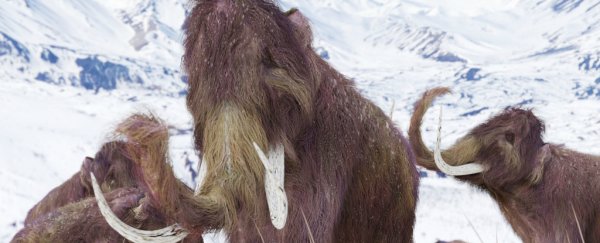Scientists are working on an ambitious plan to resurrect the woolly mammoth from extinction using genetic engineering - more than 4,000 years after the species died out on Earth.
And according to the researcher leading the 'de-extinction' project, the team could be just years away from seeing the first mammoth-elephant hybrid embryos being developed.
Their plan is to splice genes extracted from the frozen remains of woolly mammoths into the embryo of the species' closest living relative - the Asian elephant.
"Our aim is to produce a hybrid elephant-mammoth embryo," lead researcher of the Harvard University Woolly Mammoth Revival team, George Church, told Hannah Devlin at The Guardian.
"Actually, it would be more like an elephant with a number of mammoth traits. We're not there yet, but it could happen in a couple of years."
Despite some of the bold headlines, these first hybrid embryos wouldn't truly be woolly mammoths - we're long way off seeing the mammoths like the ones in the image above roaming Earth's frozen plains once more.
What the team is aiming to create are Asian elephants that contain some of the distinctive genes of the extinct species.
But if the researchers can pull that off, it would still represent a huge step forward in 'de-extinction' research to see the mammoth's genes brought back to life.
The Harvard mammoth project started in 2015, with the researchers identifying several genes in the woolly mammoth genome that code for distinctive mammoth traits. The mammoth DNA was extracted from remains that had been frozen under the Siberian permafrost for millennia.
The team has already successfully spliced 45 of these mammoth genes into elephant cells to show that the technique works.
"We already know about ones to do with small ears, subcutaneous fat, hair and blood," Church told Sarah Knapton from The Telegraph.
But they're now moving towards creating the first hybrid embryo.
The plan is to take Asian elephant skin cells and then use gene editing tool CRISPR/Cas9 to insert woolly mammoth genes into the genome.
The team will also take a fertile egg cell from a female elephant, and remove its nucleus - the part of the cell that contains all the genetic material.
The researchers will then splice the genetically modified skin cell with the no-nucleus egg cell, so that the egg takes on the modified DNA.
Those eggs will be artificially stimulated to develop into embryos.
"We're working on ways to evaluate the impact of all these edits and basically trying to establish embryogenesis in the lab," Church explained.
Once the team develops an early-stage embryo, the plan is to grow them in artificial wombs rather than transplanting them back into female Asian elephants to bring them to term.
"We hope to do the entire procedure ex-vivo (outside a living body)," Church told Devlin. "It would be unreasonable to put female reproduction at risk in an endangered species."
But seeing as no mammals have been grown to term outside of the womb to date, it's questionable whether the artificial womb technology will be ready as early as the hybrid embryos.
Still, Church is confident that they can pull it off, and says his team has already managed to use artificial wombs to grow mice embryos to halfway through gestation.
"We're testing the growth of mice ex-vivo. There are experiments in the literature from the 1980s but there hasn't been much interest for a while," he said. "Today we've got a whole new set of technology and we're taking a fresh look at it."
Church will be presenting his work at the 2017 annual meeting of the American Association for the Advancement of Science (AAAS) in Boston this week.
His team's 'embryogenesis' technique hasn't been tested or peer-reviewed as yet, so for now, we have to take his claims about the first hybrid embryo being just two years away with a big grain of salt.
But even if they can pull it off, there are ethical concerns about bringing back genes that have been extinct for thousands of years to consider.
"The proposed 'de-extinction' of mammoths raises a massive ethical issue - the mammoth was not simply a set of genes, it was a social animal, as is the modern Asian elephant," Matthew Cobb, a zoologist from the University of Manchester who isn't involved in the project, told The Guardian.
"What will happen when the elephant-mammoth hybrid is born? How will it be greeted by elephants?"
Others are more excited by the prospect - Edze Westra, a CRISPR expert from the University of Exeter in the UK, told The Telegraph. "What George Church is doing in trying to revive particular species I think represents a massive opportunity."
"One can also use this technology for engineering the DNA of rapidly declining species or those that are becoming too inbred to increase their chance of survival," he added.
But it's not just about bringing a species back from the dead. Church told the media that their project has two goals - securing an alternative future for the endangered Asian elephant, and helping to combat global warming.
That last point might sound weird, but mammoth-elephant hybrids could actually play an important role in preventing tundra permafrost from melting and releasing huge amounts of greenhouse has into our atmosphere.
"They keep the tundra from thawing by punching through snow and allowing cold air to come in," said Church. "In the summer they knock down trees and help the grass grow."
Church will be presenting his team's latest research at the AAAS 2017 meeting this week.
